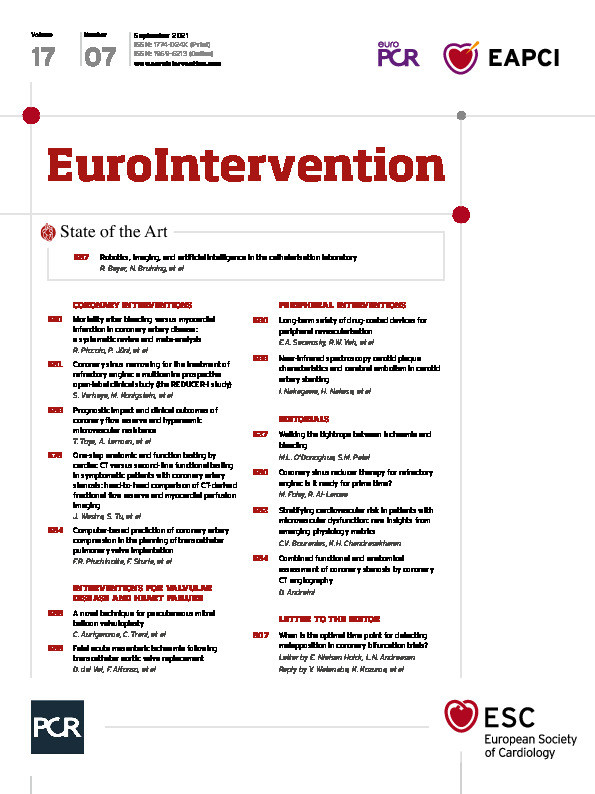Ischaemic events and bleeding remain common complications in patients with coronary artery disease (CAD), particularly after an acute coronary syndrome (ACS) or percutaneous coronary intervention (PCI). While intensification and prolongation of antiplatelet therapies help to attenuate the risk of thrombotic events, this benefit is typically accompanied by a significant increase in major and minor bleeding. To date, several studies have highlighted that bleeding is associated with an increased risk of death1. However, the relative prognostic impact of a bleeding event versus myocardial infarction (MI) remains disputed. Some trials of more intensive antithrombotic therapy have demonstrated a reduction in both recurrent MI and death despite an increase in bleeding, while some trials have suggested that an excess in bleeding may attenuate or negate any survival benefit2. These inconsistent findings highlight the fact that the mechanism by which bleeding may increase mortality remains incompletely understood as relatively few patients die of a direct complication of bleeding (e.g., intracranial haemorrhage or haemorrhagic shock).
In the current issue of EuroIntervention, Piccolo and colleagues3 build upon prior studies investigating the relative prognostic impact of a bleeding or MI event in patients with CAD by conducting a meta-analysis of published studies.
The current analysis included 41,059 patients with CAD across 16 studies, of whom 91% had undergone PCI and 63% had ACS. Each individual study examined the association between bleeding, MI, and subsequent risk of all-cause mortality with multivariable adjustment. Despite marked heterogeneity in the results across individual studies, the authors concluded that the overall excess risk of death after major bleeding (HR 4.44, 95% CI: 3.02-6.52) was comparable to the excess risk of death after MI (HR 4.10, 95% CI: 3.34-5.03; relative HR 1.10, 95% CI: 0.71-1.71; p=0.668). Furthermore, it was suggested that the relative risk of death after an early bleeding event (<30 days post ACS or PCI; HR 3.77, 95% CI: 3.23-4.41) was higher than after early MI (HR 2.45, 95% CI: 1.98-3.02; relative HR 1.46, 95% CI: 1.13-1.89; p=0.004). Unfortunately, further information regarding MI size and type was not available, making it difficult to interpret whether early MI events in this analysis reflected smaller periprocedural versus larger spontaneous events. Furthermore, it remains unclear whether some patients experienced both bleeding and MI and in what sequence. Death classification and other clinical outcomes were not reported, thereby limiting insight into the types of death that may follow initial non-fatal ischaemic or bleeding events.
Importantly, the association between bleeding and increased risk of death was restricted primarily to patients experiencing major bleeding events. Although minor bleeding and bruising is common, major bleeding events remain infrequent when compared with fatal or non-fatal cardiovascular events in this high-risk population4. This may partially help to explain how intensification of antithrombotic therapy translates into a reduction in mortality in some trials despite an increase in bleeding.
Nonetheless, it remains elusive whether a causal pathway between bleeding and increased mortality exists. These analyses are subject to a high risk of residual confounding, as patients at risk of major bleeding often reflect a higher-risk patient group. The occurrence of bleeding in this context may therefore be an indicator of the patient’s underlying substate rather than causally related to death. Each study attempted to adjust for a varying number of relevant covariates and similar adjustment was applied to both bleeding and MI models. Additionally, it has been hypothesised that bleeding may trigger a cascade of events that lead to death which, in some instances, may be precipitated by cessation of antithrombotic therapies. Importantly, risk factors associated with risk of MI and bleeding largely overlap and continue to pose a clinical conundrum with regard to antithrombotic therapies. To that end, numerous risk scores have been devised to help clinicians weigh the relative risk of bleeding and ischaemic events for their patients5.
In summary, the current study underscores the poor prognostic implications of major bleeding events which must be considered in the context of intensification and prolongation of antithrombotic therapy. Moreover, long-term management of patients after a bleeding event remains challenging as clinicians remain unsure whether it may necessitate temporary or permanent cessation of some antithrombotic therapies. Further investigation is warranted to determine whether it is possible to curtail the associated excess risk in mortality in these patients. Accumulating evidence has demonstrated safe de-escalation or abbreviation of dual antiplatelet therapy in selected patients after ACS or PCI without a clear excess in thrombotic risk6,7. Future efforts directed at refining patient-specific risk for both ischaemia and bleeding as well as ongoing investigation into how these ultimately contribute to risk of death will serve to inform clinical decision making better.
Conflict of interest statement
M. O'Donoghue has received grant support to Brigham and Women's Hospital from Amgen, Novartis, AstraZeneca, Intarcia and Merck, and consulting fees from Amgen, Novartis, Janssen and AstraZeneca. S. Patel has no conflicts of interest to declare.
Supplementary data
To read the full content of this article, please download the PDF.

